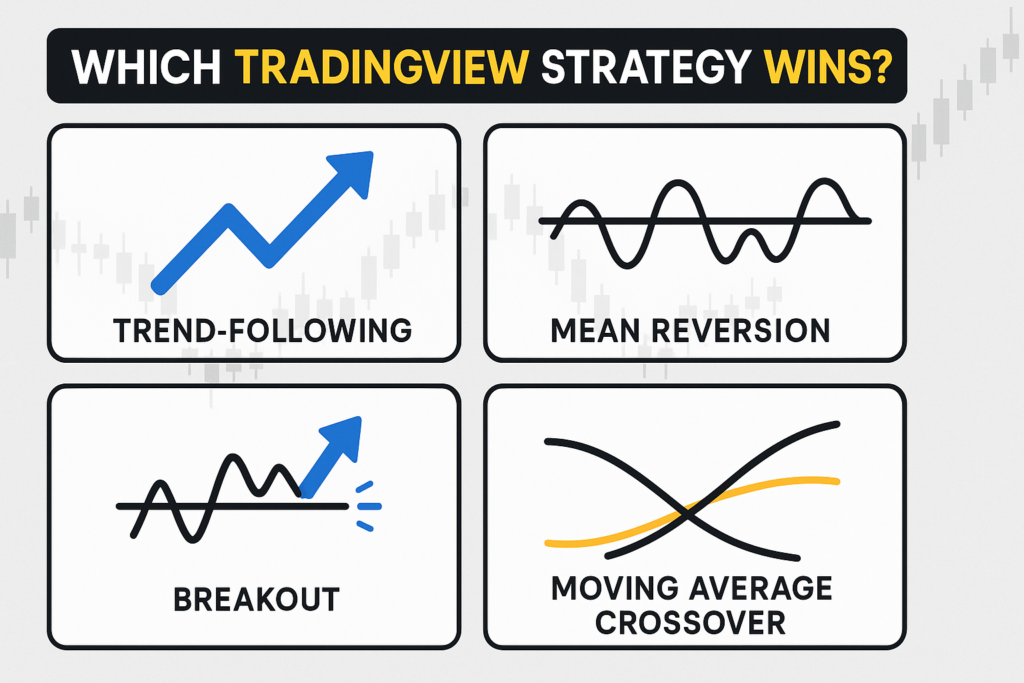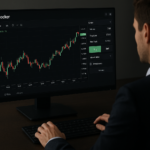Is there one TradingView strategy that rules them all? Not really.
Markets constantly shift—from trending to choppy to sideways—and each environment favors different strategies. If you’re using TradingView’s Strategy Tester and scripting with Pine Script, it’s crucial to understand when each strategy shines… and when it falls apart.
1. Trend-Following Strategies
How it works: Buy into strength. Ride the trend until it breaks.
Example: Moving Average Crossover, Supertrend.
- Win Rate: Low (~30–50%)
- Reward: High — big wins offset frequent small losses
- Best for: Trending markets (up or down)
- Weakness: Gets chopped up in sideways markets
- Pro tip: Add a trend filter (like ADX) to avoid whipsaws
Trend-following strategies are ideal for automation. You’ll lose more often than win, but the payoff when a trend sticks can be massive.
2. Mean Reversion Strategies
How it works: Fade price extremes. Assume price returns to the average.
Example: RSI Oversold/Overbought, Bollinger Band bounce.
- Win Rate: High (~60–80%)
- Reward: Low — small wins, occasional large loss
- Best for: Range-bound or sideways markets
- Weakness: Blows up in strong trends
- Pro tip: Use strict stop-losses and avoid during news or breakouts
Great for building confidence with frequent winners, but you must control risk—one big loser can erase dozens of small gains.
3. Breakout Strategies
How it works: Buy when price escapes consolidation.
Example: Donchian Channel breakout, Opening Range Breakout.
- Win Rate: Moderate (~40–50%)
- Reward: High — some breakouts run far
- Best for: Volatile market shifts
- Weakness: False breakouts = many small losses
- Pro tip: Confirm breakouts with volume
Breakouts are powerful when volatility spikes, but demand discipline. Most breakouts fail—cut losses fast, and let winners run.
4. Moving Average Crossover
How it works: A faster MA crossing a slower one signals trend change.
Example: 50/200-day Golden Cross.
- Win Rate: Low to moderate
- Reward: Moderate — depends on trend strength
- Best for: Clear up/down trends
- Weakness: Lags and whipsaws in sideways markets
- Pro tip: Combine with RSI or volume filter to improve signal quality
MA crossovers are a favorite for Pine Script beginners. Easy to test, automate, and interpret.
Which One Should You Use?
There’s no single “best” TradingView strategy. But here’s a rule of thumb:
| Market Type | Best Strategy |
|---|---|
| Strong Trends | Trend-Following / MA X |
| Range-Bound | Mean Reversion |
| Breakout Conditions | Breakout Strategy |
The real edge? Adapting. Or better yet—combining multiple strategies and toggling based on the regime.
Final Tips for Algo Traders Using TradingView
- Backtest across different timeframes. A great strategy on BTC 1H might fail on SPX daily.
- Monitor win rate and profit factor. A 70% win rate means nothing if your losses are 3x your wins.
- Use Pine Script inputs. Make your parameters adjustable so you can test without recoding.
- Avoid curve fitting. Keep it simple and robust—avoid over-optimized setups.
In short: test it, break it, adapt it.
TradingView’s Strategy Tester gives you the data. Your job is to turn that data into discipline.
And if you want to automate your TradingView strategies live with full control over risk, take-profit, and multi-account execution—PickMyTrade does the heavy lifting for you.



